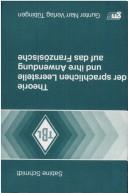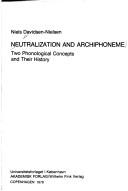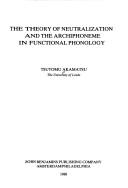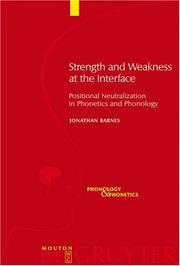| Listing 1 - 10 of 48 | << page >> |
Sort by
|

ISBN: 3878083386 9783878083382 Year: 1989 Volume: 337 Publisher: Tübingen: Narr,
Abstract | Keywords | Export | Availability | Bookmark
 Loading...
Loading...Choose an application
- Reference Manager
- EndNote
- RefWorks (Direct export to RefWorks)
French language --- Grammar --- Neutralization (Linguistics) --- Neutralization. --- -Langue d'oïl --- Romance languages --- Grammar, Comparative and general --- Linguistics --- Neutralization --- Phonology --- -Neutralization --- Neutralization (Linguistics). --- Langue d'oïl --- French language - Neutralization.
Book
Abstract | Keywords | Export | Availability | Bookmark
 Loading...
Loading...Choose an application
- Reference Manager
- EndNote
- RefWorks (Direct export to RefWorks)
Influenza virus infections lead to thousands of deaths worldwide annually and billions of dollars economic burden. Despite continuing advances in our understanding of the immune evasion mechanism, the disease remains one of the foremost threat for human being. Traditional vaccines (attenuated and inactivated) mainly provide protection by inducing virus neutralizing antibodies, targeting ever changing surface antigens: Haemagultinin (HA) and Neuraminidase (NA). Due to genetic shift and immune selection pressure, prevalence of circulating influenza virus subtypes changes every year. Therefore, mismatch between circulating strain and vaccine strain can critically affect the success rate of these conventional flu vaccines, and requires continuous monitoring of circulating influenza virus subtypes and change in the vaccine formulations accordingly. The collective limitations of existing flu vaccines urgently call for the development of a novel universal vaccines that might provide the required protective immunity to a range of influenza virus subtypes. New approaches are being investigated mainly targeting conserved regions of flu proteins. Some of these approaches include universally conserved epitopes of HA, nucleoprotein (NP), capsid protein (M1) and ion channel protein (M2) that induced strong immune responses in animal models. Some attention and progress appears to be focused on vaccines based on the M2 ectodomain (M2e) employing a variety of constructs, adjuvants and delivery systems, including M2e-hepatitis B core antigen, flagellin constructs, and virus-like particles (VLP). Animal studies with these M2e candidate vaccines demonstrated that these vaccine candidates can prevent severe illness and death but not infection, which may pose difficulties in both the evaluation of clinical efficacy and approval by the regulatory authorities. VLP vaccines appear to be promising, but still are mostly limited to animal studies. The discovery and development of new and improved vaccines have been greatly facilitated by the application of new technologies. The use of nucleic acid-based vaccines, to combine the benefits of in-situ expression of antigens with the safety of inactivated and subunit vaccines, has been a key advancement. Upon their discovery more than 20 years ago, nucleic acid vaccines promised to be a safe and effective mean to mimic immunization with a live organism vaccine, particularly for induction of T cell immunity. In addition, the manufacturing of nucleic acid-based vaccines offered the potential to be relatively simple, inexpensive and generic. Reverse Vaccinology and in-silico designing of vaccines are very innovative approaches and being considered as future of vaccines. Furthermore, various immuno-therapeutic agents also being developed to treat and minimize immuno-pathological damage in patients suffering from life threatening complications. For the treatment of such pathological conditions, various novel approaches such as administration of immune suppressive cytokines, blocking co-stimulatory signals or activating co-inhibitory signal of T cell activation, are being tested both in lab and clinics. The Research Topic on influenza virus vaccine and therapeutics will give an insight in to the current status and future scope of these new innovative approaches and technologies. Moreover, these new methods will also serve as a reference tool for the development of future vaccines against several other pathogens.
T Cell Immunity --- Neutralization antibody --- Influenza Virus --- Vaccine --- Immunotherepy --- adjuvants
Book
Abstract | Keywords | Export | Availability | Bookmark
 Loading...
Loading...Choose an application
- Reference Manager
- EndNote
- RefWorks (Direct export to RefWorks)
Influenza virus infections lead to thousands of deaths worldwide annually and billions of dollars economic burden. Despite continuing advances in our understanding of the immune evasion mechanism, the disease remains one of the foremost threat for human being. Traditional vaccines (attenuated and inactivated) mainly provide protection by inducing virus neutralizing antibodies, targeting ever changing surface antigens: Haemagultinin (HA) and Neuraminidase (NA). Due to genetic shift and immune selection pressure, prevalence of circulating influenza virus subtypes changes every year. Therefore, mismatch between circulating strain and vaccine strain can critically affect the success rate of these conventional flu vaccines, and requires continuous monitoring of circulating influenza virus subtypes and change in the vaccine formulations accordingly. The collective limitations of existing flu vaccines urgently call for the development of a novel universal vaccines that might provide the required protective immunity to a range of influenza virus subtypes. New approaches are being investigated mainly targeting conserved regions of flu proteins. Some of these approaches include universally conserved epitopes of HA, nucleoprotein (NP), capsid protein (M1) and ion channel protein (M2) that induced strong immune responses in animal models. Some attention and progress appears to be focused on vaccines based on the M2 ectodomain (M2e) employing a variety of constructs, adjuvants and delivery systems, including M2e-hepatitis B core antigen, flagellin constructs, and virus-like particles (VLP). Animal studies with these M2e candidate vaccines demonstrated that these vaccine candidates can prevent severe illness and death but not infection, which may pose difficulties in both the evaluation of clinical efficacy and approval by the regulatory authorities. VLP vaccines appear to be promising, but still are mostly limited to animal studies. The discovery and development of new and improved vaccines have been greatly facilitated by the application of new technologies. The use of nucleic acid-based vaccines, to combine the benefits of in-situ expression of antigens with the safety of inactivated and subunit vaccines, has been a key advancement. Upon their discovery more than 20 years ago, nucleic acid vaccines promised to be a safe and effective mean to mimic immunization with a live organism vaccine, particularly for induction of T cell immunity. In addition, the manufacturing of nucleic acid-based vaccines offered the potential to be relatively simple, inexpensive and generic. Reverse Vaccinology and in-silico designing of vaccines are very innovative approaches and being considered as future of vaccines. Furthermore, various immuno-therapeutic agents also being developed to treat and minimize immuno-pathological damage in patients suffering from life threatening complications. For the treatment of such pathological conditions, various novel approaches such as administration of immune suppressive cytokines, blocking co-stimulatory signals or activating co-inhibitory signal of T cell activation, are being tested both in lab and clinics. The Research Topic on influenza virus vaccine and therapeutics will give an insight in to the current status and future scope of these new innovative approaches and technologies. Moreover, these new methods will also serve as a reference tool for the development of future vaccines against several other pathogens.
T Cell Immunity --- Neutralization antibody --- Influenza Virus --- Vaccine --- Immunotherepy --- adjuvants
Book
Abstract | Keywords | Export | Availability | Bookmark
 Loading...
Loading...Choose an application
- Reference Manager
- EndNote
- RefWorks (Direct export to RefWorks)
Influenza virus infections lead to thousands of deaths worldwide annually and billions of dollars economic burden. Despite continuing advances in our understanding of the immune evasion mechanism, the disease remains one of the foremost threat for human being. Traditional vaccines (attenuated and inactivated) mainly provide protection by inducing virus neutralizing antibodies, targeting ever changing surface antigens: Haemagultinin (HA) and Neuraminidase (NA). Due to genetic shift and immune selection pressure, prevalence of circulating influenza virus subtypes changes every year. Therefore, mismatch between circulating strain and vaccine strain can critically affect the success rate of these conventional flu vaccines, and requires continuous monitoring of circulating influenza virus subtypes and change in the vaccine formulations accordingly. The collective limitations of existing flu vaccines urgently call for the development of a novel universal vaccines that might provide the required protective immunity to a range of influenza virus subtypes. New approaches are being investigated mainly targeting conserved regions of flu proteins. Some of these approaches include universally conserved epitopes of HA, nucleoprotein (NP), capsid protein (M1) and ion channel protein (M2) that induced strong immune responses in animal models. Some attention and progress appears to be focused on vaccines based on the M2 ectodomain (M2e) employing a variety of constructs, adjuvants and delivery systems, including M2e-hepatitis B core antigen, flagellin constructs, and virus-like particles (VLP). Animal studies with these M2e candidate vaccines demonstrated that these vaccine candidates can prevent severe illness and death but not infection, which may pose difficulties in both the evaluation of clinical efficacy and approval by the regulatory authorities. VLP vaccines appear to be promising, but still are mostly limited to animal studies. The discovery and development of new and improved vaccines have been greatly facilitated by the application of new technologies. The use of nucleic acid-based vaccines, to combine the benefits of in-situ expression of antigens with the safety of inactivated and subunit vaccines, has been a key advancement. Upon their discovery more than 20 years ago, nucleic acid vaccines promised to be a safe and effective mean to mimic immunization with a live organism vaccine, particularly for induction of T cell immunity. In addition, the manufacturing of nucleic acid-based vaccines offered the potential to be relatively simple, inexpensive and generic. Reverse Vaccinology and in-silico designing of vaccines are very innovative approaches and being considered as future of vaccines. Furthermore, various immuno-therapeutic agents also being developed to treat and minimize immuno-pathological damage in patients suffering from life threatening complications. For the treatment of such pathological conditions, various novel approaches such as administration of immune suppressive cytokines, blocking co-stimulatory signals or activating co-inhibitory signal of T cell activation, are being tested both in lab and clinics. The Research Topic on influenza virus vaccine and therapeutics will give an insight in to the current status and future scope of these new innovative approaches and technologies. Moreover, these new methods will also serve as a reference tool for the development of future vaccines against several other pathogens.
T Cell Immunity --- Neutralization antibody --- Influenza Virus --- Vaccine --- Immunotherepy --- adjuvants

ISBN: 8750018523 Year: 1978 Volume: v. 7 Publisher: Copenhagen : Akademisk Forlag,
Abstract | Keywords | Export | Availability | Bookmark
 Loading...
Loading...Choose an application
- Reference Manager
- EndNote
- RefWorks (Direct export to RefWorks)
Grammar, Comparative and general --- Neutralization (Linguistics) --- Archiphoneme --- Neutralisation (Linguistique) --- Phonology --- History --- -Neutralization (Linguistics) --- Linguistics --- Comparative grammar --- Grammar --- Grammar, Philosophical --- Grammar, Universal --- Language and languages --- Philosophical grammar --- Philology --- Phonemics --- -History --- Grammar, Comparative --- Archiphoneme. --- History. --- Neutralization (Linguistics). --- Phonology&delete&
Book
ISBN: 9069841622 Year: 1996 Publisher: Amsterdam : European commission of preservation and acces,
Abstract | Keywords | Export | Availability | Bookmark
 Loading...
Loading...Choose an application
- Reference Manager
- EndNote
- RefWorks (Direct export to RefWorks)
025.85 --- 66.094.8 --- Onderhoud van boeken. Restauratie. Vriesdrogen. Boekbeschadiging --- Neutralization. Removal of acids or bases. Deacidification. Debasification --- 66.094.8 Neutralization. Removal of acids or bases. Deacidification. Debasification --- 025.85 Onderhoud van boeken. Restauratie. Vriesdrogen. Boekbeschadiging
Multi
ISBN: 9780521196710 9780521145015 9781139013895 9781139549011 1139549014 1139013890 052119671X 0521145015 9781139551519 1139551515 1283575086 9781283575089 1316088766 1139563866 9786613887535 1139550268 1139555227 1139553976 1139557726 9781139557726 Year: 2012 Publisher: Cambridge New York Cambridge University Press
Abstract | Keywords | Export | Availability | Bookmark
 Loading...
Loading...Choose an application
- Reference Manager
- EndNote
- RefWorks (Direct export to RefWorks)
The function of language is to transmit information from speakers to listeners. This book investigates an aspect of linguistic sound patterning that has traditionally been assumed to interfere with this function - neutralization, a conditioned limitation on the distribution of a language's contrastive values. The book provides in-depth, nuanced and critical analyses of many theoretical approaches to neutralization in phonology and argues for a strictly functional characterization of the term: neutralizing alternations are only function-negative to the extent that they derive homophones, and most surprisingly, neutralization is often function-positive, by serving as an aid to parsing. Daniel Silverman encourages the reader to challenge received notions by carefully considering these functional consequences of neutralization. The book includes a glossary, discussion points and lists of further reading to help advanced phonology students consolidate the main ideas and findings on neutralization.
Phonetics --- Neutralization (Linguistics) --- Grammar, Comparative and general --- Phonetics. --- Phonology. --- LANGUAGE ARTS & DISCIPLINES --- Linguistics --- Phonetics & Phonology. --- Neutralization (Linguistics). --- Neutralization (linguistics). --- Grammar, comparative and general --- Language arts & disciplines --- Phonetics & phonology. --- Articulatory phonetics --- Orthoepy --- Phonology --- Sound --- Speech --- Voice --- Arts and Humanities --- Language & Linguistics --- Philology --- Grammar, Comparative and general Phonology --- Neutralisation (linguistique) --- Phonétique --- Phonologie --- Phonétique
Book
ISBN: 0918006198 Year: 1990 Publisher: Washington Association of Research Libraries
Abstract | Keywords | Export | Availability | Bookmark
 Loading...
Loading...Choose an application
- Reference Manager
- EndNote
- RefWorks (Direct export to RefWorks)
025.85 --- 66.094.8 --- Onderhoud van boeken. Restauratie. Vriesdrogen. Boekbeschadiging --- Neutralization. Removal of acids or bases. Deacidification. Debasification --- 66.094.8 Neutralization. Removal of acids or bases. Deacidification. Debasification --- 025.85 Onderhoud van boeken. Restauratie. Vriesdrogen. Boekbeschadiging --- Books --- Library materials --- Conservation of library materials --- Preservation of library materials --- Deacidification of books --- Neutralization (Chemistry) --- Paper --- Deacidification --- Conservation and restoration --- Preservation --- Decision making

ISBN: 9027235376 9786613313805 1283313804 902727875X 9789027235374 9789027278753 9781283313803 6613313807 Year: 1988 Volume: 43 Publisher: Amsterdam Philadelphia J. Benjamins
Abstract | Keywords | Export | Availability | Bookmark
 Loading...
Loading...Choose an application
- Reference Manager
- EndNote
- RefWorks (Direct export to RefWorks)
Grammar, Comparative and general --- Neutralization (Linguistics) --- Archiphoneme. --- Phonology. --- Neutralization (Linguistics). --- Phonetics --- 801.4 --- Archiphoneme --- -Neutralization (Linguistics) --- Linguistics --- Phonemics --- 801.4 Fonetiek. Fonologie --- Fonetiek. Fonologie --- Comparative grammar --- Grammar --- Grammar, Philosophical --- Grammar, Universal --- Language and languages --- Philosophical grammar --- Philology --- Phonology --- Grammar, Comparative --- Grammar, Comparative and general Phonology

ISBN: 1282193988 9786612193989 3110197618 3110185210 9783110185218 9783110197617 9781282193987 6612193980 Year: 2006 Publisher: Berlin New York Mouton de Gruyter
Abstract | Keywords | Export | Availability | Bookmark
 Loading...
Loading...Choose an application
- Reference Manager
- EndNote
- RefWorks (Direct export to RefWorks)
This thorough study of the expression of contrast in the world's vowel systems examines phonetic and phonological differences between so-called strong and weak positions, bringing the full range of data from positional neutralization systems to bear on central questions at the interface between phonetics and phonology. The author draws evidence from a diverse array of sources, bringing together cross-linguistic typological surveys, detailed investigations of the diachrony of specific languages (Slavic, Turkic, Uralic, Austronesian, among many others) and original studies in experimental phonetics. Devoted at once to empirical coverage and to theoretical investigation, this is the first work to compile so exhaustive a study of positional neutralization patterns in the languages of the world. On the basis of this catalog of evidence, the author argues for a diachronically oriented approach to the phonetic motivations behind phonological patterns, with phonologization as its central mechanism. Three pairs of traditionally-identified strong and weak positions for the realization of vowel contrasts are selected and examined in detail: stressed and unstressed syllables, domain final and non-final syllables, and domain initial and non-initial syllables. Neutralization patterns in each position are extracted from survey data, and analyzed in light of the phonetic characteristics of each pair of positions. Both the nature of the patterns identified as well as the variety and sources of exceptions have important consequences for formal phonology, phonetics, and historical linguistics as well.
Grammar, Comparative and general --- Neutralization (Linguistics) --- Phonetics. --- Articulatory phonetics --- Orthoepy --- Phonology --- Linguistics --- Speech --- Phonology. --- Philology --- Grammar, Comparative and general Phonology --- phonology.
| Listing 1 - 10 of 48 | << page >> |
Sort by
|

 Search
Search Feedback
Feedback About UniCat
About UniCat  Help
Help News
News